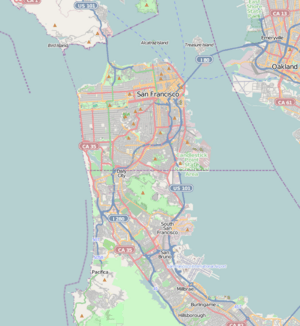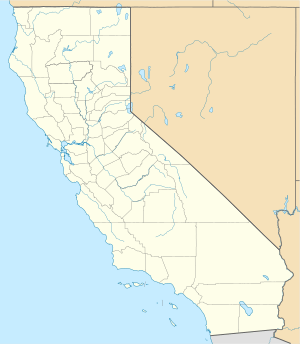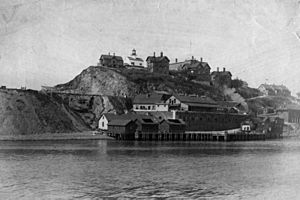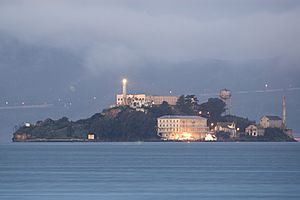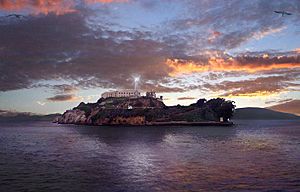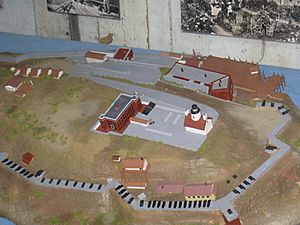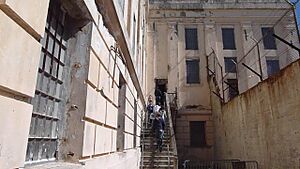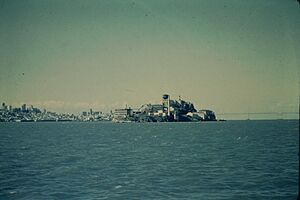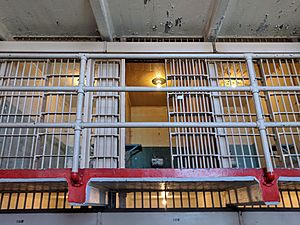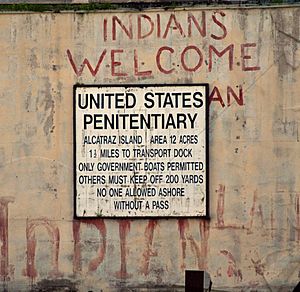Alcatraz Island facts for kids
Quick facts for kids Alcatraz Island |
|
|---|---|
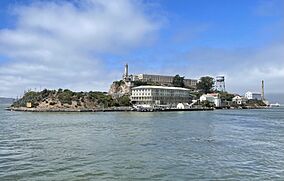
Alcatraz Island in San Francisco Bay from the east
|
|
| Location | San Francisco Bay, California, U.S. |
| Nearest city | San Francisco, California |
| Area | 22 acres (8.9 ha) |
| Established | 1934 |
| Governing body | National Park Service |
| Website | Alcatraz Island |
|
Alcatraz
|
|
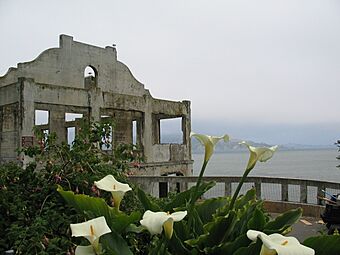
The Social Hall, destroyed by fire during the Native American occupation
|
|
| Area | 47 acres (19 ha) |
| Built | 1847 |
| Architect | U.S. Army, Bureau of Prisons; U.S. Army |
| Architectural style | Mission/Spanish Revival |
| NRHP reference No. | 76000209 |
| Significant dates | |
| Added to NRHP | June 23, 1976 |
| Designated NHLD | January 17, 1986 |
Alcatraz Island is a small island located about 1.25 miles (2 km) off the coast of San Francisco in San Francisco Bay, California. It's close to the famous Golden Gate Strait. This island has a fascinating history, starting in the mid-19th century.
First, it was home to a lighthouse, then a military fort, and later a military prison. In 1934, it became a famous federal prison, the Alcatraz Federal Penitentiary. The strong ocean currents and very cold water around the island made it almost impossible for anyone to escape. This gave Alcatraz a reputation as one of the toughest prisons in American history. The prison closed on March 21, 1963. Today, it's a very popular place for tourists to visit.
In November 1969, a group of Native Americans began an important protest on the island. They stayed for over 19 months. This protest was part of a larger movement for Indigenous rights across the United States. In 1972, Alcatraz became part of the Golden Gate National Recreation Area. It was recognized as a National Historic Landmark in 1986.
Today, the National Park Service manages Alcatraz Island. It's still part of the Golden Gate National Recreation Area. Visitors can take a ferry from Pier 33 in San Francisco to reach the island.
Alcatraz Island is known for its old federal prison, the oldest working lighthouse on the West Coast of the United States, and old military fortifications. It also has cool natural features like rock pools and a home for seabirds. You can see western gulls, cormorants, and egrets there. The island is about 1,675 feet (511 m) long and 590 feet (180 m) wide. Its highest point is 135 feet (41 m) above the water. The whole island covers about 22 acres (8.9 hectares).
Some important places on the island include the Main Cellhouse (where prisoners lived), the Dining Hall, the Lighthouse, and the ruins of the Warden's House. There's also the Water Tower and the Recreation Yard.
Contents
Exploring Alcatraz Island's Past
How Alcatraz Got Its Name
The first European to write about the islands in San Francisco Bay was a Spanish explorer named Juan Manuel de Ayala in 1775. He named a different island, Yerba Buena Island, "La Isla de los Alcatraces." This means "The Island of the Gannets" or "The Island of the Pelicans."
Later, an English naval officer, Captain Frederick W. Beechey, used the name "Alcatraz" for the island we know today. The Spanish name "Alcatraz" became very popular. In 1827, a French captain wrote about "Alcatraze's (Pelicans) Island" being covered with countless birds. Today, California brown pelicans don't nest on the island.
Alcatraz as a Fort
The island of Alcatraz was first owned by Julian Workman in 1846. He was supposed to build a lighthouse there. Later that year, John C. Frémont, a military governor, bought the island for the United States government.
In 1850, President Millard Fillmore declared Alcatraz Island a military area. This was after the U.S. gained California from Mexico. The U.S. Army started building defenses on the island in 1853. By 1858, the first version of Fort Alcatraz was finished.
When the American Civil War started in 1861, the island had many cannons to protect San Francisco Bay. It also stored firearms to keep them safe. Alcatraz was a key part of a "triangle of defense" for the bay. The first working lighthouse on the West Coast was also built here. During the war, Fort Alcatraz held prisoners, but its cannons were never used in battle.
Scientists have used special radar to study the island's old fortifications. In 2019, archaeologists found hidden structures, like tunnels and ventilation ducts, beneath the old recreation yard. They also found remains of ammunition storage areas.
Because of the cold, strong currents, Alcatraz was used to hold soldiers who committed crimes as early as 1859. By 1861, it was the military prison for the Pacific region. It held Civil War prisoners of war (POWs).
After the Civil War, Alcatraz's defenses became outdated. The army decided to use Alcatraz mainly as a prison. Its isolated location made it perfect for this. In 1868, Alcatraz officially became a long-term prison for military prisoners. Some Hopi Native American men were also held there in the 1870s.
During the Spanish–American War in 1898, the prison population grew a lot. After the 1906 San Francisco earthquake, civilian prisoners were moved to Alcatraz for safety. In 1907, it became the official Western U.S. Military Prison.
In 1909, construction began on the large concrete main cell block. This building is still the most noticeable feature on the island. It was finished in 1912. The old three-story barracks, called the Citadel, was partly torn down and became the basement of the new cell block. This led to stories about "dungeons" under the prison. The military prison closed in 1933.
Alcatraz Federal Prison: The Rock
The U.S. Department of Justice took over Alcatraz in 1933. In August 1934, it became a federal prison. Alcatraz was meant for prisoners who caused a lot of trouble in other federal prisons. On August 11, 1934, the first 137 prisoners arrived. They were escorted by many special agents.
Many of these prisoners were famous bank robbers and murderers. The prison staff were highly trained in security.
For 29 years, Alcatraz held some of America's most well-known criminals. These included gangsters like Al Capone and Robert Franklin Stroud, known as the "Birdman of Alcatraz."
The prison claimed that no prisoner ever successfully escaped. A total of 36 prisoners tried to escape 14 times. Most were caught, some were shot, and others drowned. Five are still missing and presumed drowned. The most violent event was the Battle of Alcatraz in 1946, a failed escape attempt.
The most famous escape happened on June 11, 1962. Frank Morris, John Anglin, and Clarence Anglin tried to escape. They are believed to have drowned, but their bodies were never found. This led to many stories that they might have made it to shore.
The Anglin brothers and Frank Morris dug through a vent for about three months. They used sharpened spoons and a vacuum cleaner motor drill. They also filed down the bolts of the roof vents. To trick the guards, they made fake heads from paper mache and hair clippings. These dummies made it look like they were still in their beds during nightly checks.
Escaping the prison was only half the plan. They still had to cross 1.25 miles (2 km) of cold, shark-infested waters. They built rafts from prison rain jackets and life preservers. They used waterproof glue to hold the rafts together. They also made wooden paddles from scrap wood. To inflate their raft, they used a concertina (a musical instrument). They escaped around 10 p.m. on June 11, 1962, and were never seen again. Another prisoner, Allen West, was supposed to join them but couldn't get out of his cell in time. He later told the FBI all the details of their plan.
In 1962, prisoner John Paul Scott did make it to shore. However, he was so tired and cold that police found him unconscious. Today, the annual Escape from Alcatraz Triathlon includes a 1.5-mile (2.4 km) swim from the island to the bay shore.
Why the Prison Closed
Alcatraz closed as a prison in 1963 for several reasons. It was very expensive to run, costing much more per prisoner than other prisons. Also, decades of salt water had badly damaged the buildings. The famous 1962 escape attempt also played a role.
Native American Occupation of Alcatraz
Native American activists first protested on Alcatraz Island on March 8, 1964. Then, starting on November 20, 1969, a group called United Indians of All Tribes occupied the island. Many were college students from San Francisco. They were protesting federal policies that affected American Indians. These policies encouraged Native Americans to move from Indian reservations to cities.
The occupiers stayed on the island for almost two years. They wanted the island to become an Indian education, ecology, and cultural center. They claimed the island based on the Treaty of Fort Laramie (1868). This treaty said that retired federal lands should go back to Native peoples. The occupation drew Native Americans from all over the country.
During the occupation, some buildings were damaged or destroyed by fire. These included the lighthouse keeper's home and the warden's home. The U.S. government later tore down other buildings. You can still see Graffiti from the Native American occupation on the island today.
During this time, President Richard Nixon changed federal policy. He ended the old policy that tried to make tribes lose their special relationship with the U.S. government. He started a new policy of Native American self-determination. This change was partly because of the attention the Alcatraz occupation brought. The occupation ended on June 11, 1971.
Alcatraz Today: A National Park Site
In 1972, the National Park Service bought Alcatraz. It became part of the Golden Gate National Recreation Area. Today, it's a popular tourist spot and museum. It teaches visitors about its time as a federal prison.
In 2025, there was a proposal to reopen the island's prison. President Donald Trump mentioned it as an idea to deal with immigration issues. However, this plan was just an idea and did not move forward.
Important Places on Alcatraz
Alcatraz Island became part of the National Register of Historic Places in 1976. In 1986, it was named a National Historic Landmark. This is a very high honor.
In 1993, the National Park Service made a plan to open more of Alcatraz to the public. This allowed visitors to enjoy its beautiful scenery and see its birds and marine life.
Some of the main landmarks you can see include:
- Boat Dock
- Building 64
- Dining Hall
- Library
- Lighthouse
- Main Cellhouse
- Model Industries Building
- New Industries Building
- Parade Grounds
- Power House
- Recreation Yard
- Warden's House
- Water Tower
What's Happening on Alcatraz Now
Native American groups, like the International Indian Treaty Council, sometimes hold special ceremonies on the island. Their "Sunrise Gatherings" on Columbus Day and Thanksgiving Day are well-known.
Around 2007, a group proposed tearing down the prison to build a peace center. This idea was very expensive and faced a lot of criticism. Many felt Alcatraz's history was too important to destroy. In 2008, voters rejected the plan.
The salty air and water of San Francisco Bay have caused the buildings on Alcatraz to wear down. Since 2011, the National Park Service has been doing major renovations. They've added solar panels, stabilized slopes, and repaired walls.
Alcatraz is now one of San Francisco's top tourist spots. In 2018, about 1.7 million people visited each year. Visitors arrive by ferry. The old prison buildings are being preserved and made safer. More areas of the island are opening to the public as hazards are removed. During the COVID-19 pandemic, the island was closed for over a year but reopened in March 2021.
Art on the Island
Alcatraz has also hosted several art exhibits. In 2014, artist Ai Weiwei created an exhibition called "@Large." It explored human rights and freedom of expression, using Lego portraits of famous political prisoners. In 2016, Nelson Saiers used math and prison slang in an installation to highlight long prison sentences.
Animals and Plants of Alcatraz
Island Habitats
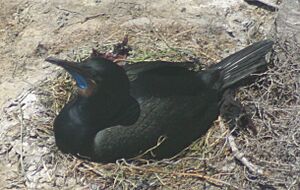
Alcatraz has different natural areas that are home to various creatures:
- Cisterns: These moist, rocky areas are important for California slender salamanders.
- Cliff tops: The northern cliffs are important nesting and roosting spots for birds.
- Powerhouse area: This steep area has native grasses and wild rye, providing a home for deer mice.
- Tide pools: These pools, created by old quarrying, are one of the few in San Francisco Bay. They have many small sea creatures.
- Western cliffs: These cliffs, almost 100 feet (30 m) high, are nesting and roosting sites for seabirds like pigeon guillemots, cormorants, and western gulls. You might also see harbor seals on a small beach below.
- Parade grounds: This area, once flattened for military use, is now a breeding ground for black-crowned night herons, western gulls, salamanders, and deer mice.
- Agave Path: This trail, named for its thick agave plants, is a nesting place for night herons.
Island Plants
Gardens planted by military families and later by prison guards were left untended after the prison closed in 1963. After 40 years, these gardens are being restored by staff and volunteers. They are funded by groups like the Garden Conservancy. The overgrown gardens had become a safe haven for many birds. Now, bird habitats are protected, while many gardens are being brought back to their original state.
During the cleanup, workers found many original plants still growing, some over 100 years old. They discovered rare heirloom roses, including a Welsh rose thought to be extinct. Many types of roses, succulents, and geraniums grow among apple and fig trees, sweet peas, and wild sections of native grasses.
Images for kids
See also
 In Spanish: Isla de Alcatraz para niños
In Spanish: Isla de Alcatraz para niños
- Asinara
- Cellular Jail
- Château d'If
- Devil's Island
- Fort Denison
- List of islands of California
- Robben Island
- San Lucas Island
- Alligator Alcatraz


